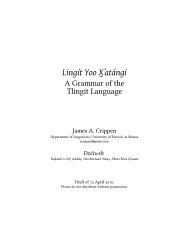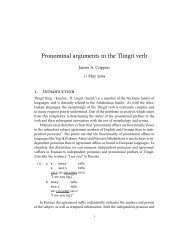A comparison of morphosyntactic features between Marquesan ...
A comparison of morphosyntactic features between Marquesan ...
A comparison of morphosyntactic features between Marquesan ...
Create successful ePaper yourself
Turn your PDF publications into a flip-book with our unique Google optimized e-Paper software.
2.1. DEFINITE NA<br />
No. HAW MQA TAH DEF SPEC<br />
SG ke~ka te te ± ±<br />
DL — na nā +<br />
PC — na nā +<br />
PL nā na — +<br />
Table 1: Basic “definite” articles in HAW, MQA, and TAH.<br />
HAW nā is the definite plural article corresponding to the definite singular ka~ke<br />
(Elbert & Pukui 1979).<br />
According to Mutu & Teìkitutoua (2002:75), MQA na 1 is a “definite, specific,<br />
and paucal [article] indicating either two or a small number”, and corresponds to<br />
the definite singular te. Cablitz (2006:140) says it “expresses that a noun phrase<br />
refers to definite plural entities”, but that the entities are usually limited to two<br />
which is shown by other indicators in context. She also notes that na is only used<br />
by older speakers. In glosses, Cablitz gives na as “ART.dl/pl”, indicating that it<br />
functions as either a dual or a plural. Cablitz is elsewhere fairly scrupulous about<br />
the distinction <strong>between</strong> specific and non-specific articles, but here she does not<br />
mention whether na has a particular focus on one or the other. In a later comment<br />
on this she states that na is considered by her to be specific (Cablitz, p.c.).<br />
TAH nā (given as na by some) is a dual article according to Vernier & Drollet<br />
(1968), although they also claim it can express a “limited plural reduced to several<br />
units”, what is probably a paucal. Indeed, Lazard & Peltzer (2000:207) describe TAH<br />
nā as “article paucal” giving a translation as “les (deux, quelques)” (tr. “the (two,<br />
some)”) which indicates that it may function as either a dual or a paucal. Again,<br />
TAH nā corresponds to the definite singular article te. Tryon (1970:11) describes<br />
this article as both a dual and as a paucal “used with numbers up to ten, with reference<br />
to persons, if the actual number is specified”. No source describes TAH nā<br />
as a definite article, but the glosses and translations in each suggest that this is the<br />
case. e question remains whether TAH nā is a specific article.<br />
Functional <strong>comparison</strong> <strong>of</strong> these articles shows that MQA and TAH preserve essentially<br />
the same definite specific dual/paucal article descended from PCE *na(a),<br />
however HAW nā has changed it into a definite plural article. Note that the number<br />
<strong>of</strong> MQA na is intermediate <strong>between</strong> TAH and HAW. is could indicate that MQA<br />
1. Perhaps MQA may also be nā Mutu & Teìkitutoua denote vowel length and give na, but Cablitz<br />
does not give vowel length. ere may be no distinction.<br />
2





